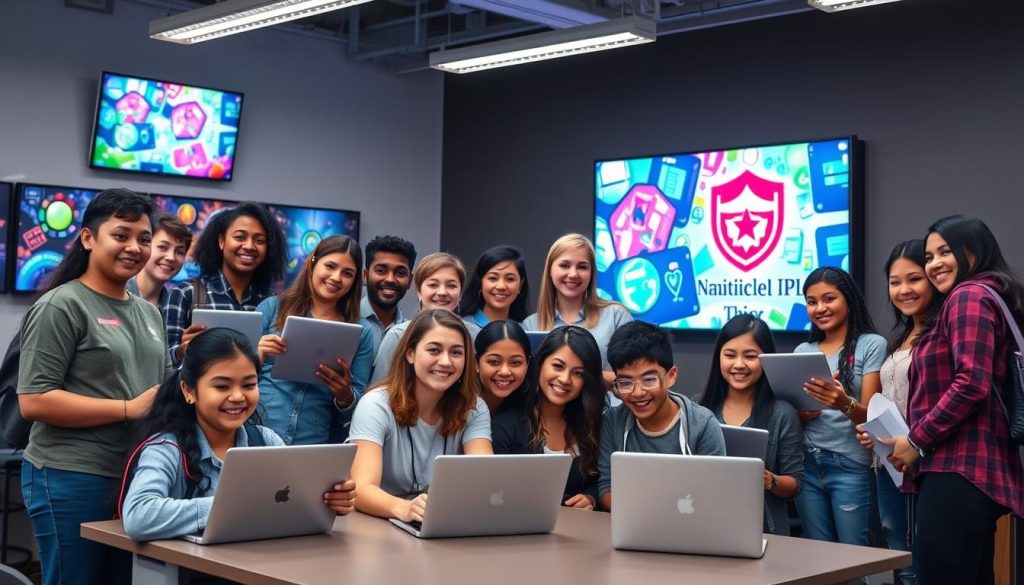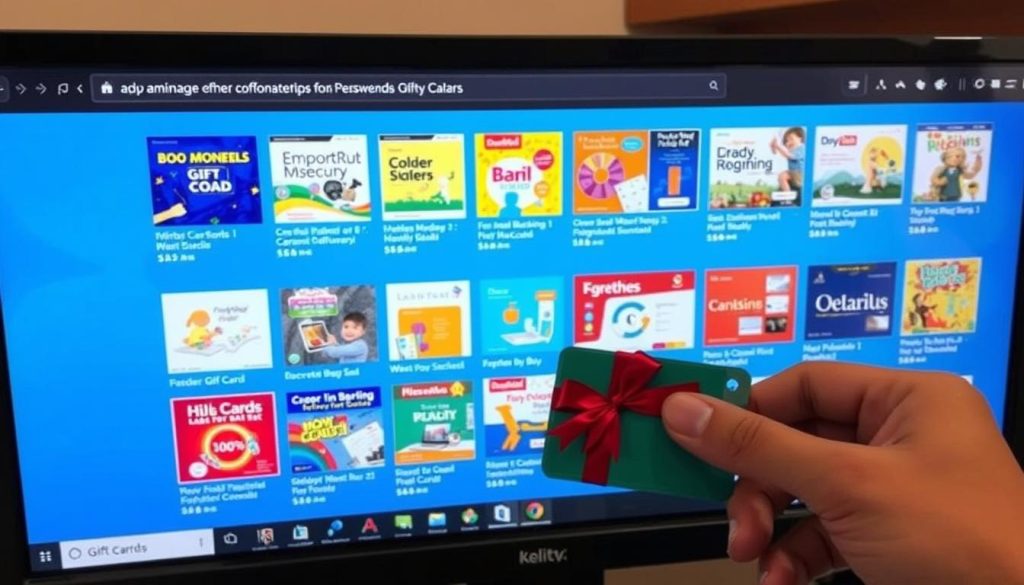Promoting software in the educational sector is crucial for success in today’s digital world. Reaching students, educators, and school administrators is key to driving awareness and adoption. This approach is vital for software developers, edtech companies, and educational institutions alike.
Effective engagement with these groups can lead to long-term success for your educational software offerings. Understanding your audience’s needs is essential for crafting a compelling promotion strategy.
Key Takeaways
- Leverage the diverse landscape of educational software platforms to reach your target audience
- Craft a compelling software promotion strategy that resonates with educators and students
- Utilize social media and online communities to effectively connect with your educational stakeholders
- Collaborate with educational institutions to pilot your software and gain valuable feedback
- Optimize your software’s discoverability through strategic keyword research and SEO best practices
Understanding the Educational Software Landscape
Educational technology covers a wide range of tools. Each tool is designed for specific needs in education. Understanding this landscape is key to promoting your software effectively.
Types of Educational Software
Some of the most prominent types of educational software include:
- Learning Management Systems (LMS): These platforms facilitate online course delivery, assignment management, and student engagement.
- Digital Curricula: Comprehensive, interactive digital learning materials that can be seamlessly integrated into classroom instruction.
- Assessment Tools: Software designed to streamline the evaluation of student progress, provide personalized feedback, and generate insightful data.
- Student Engagement Platforms: Tools that foster collaboration, promote active learning, and enhance the overall educational experience.
Identifying Target Platforms
Finding the right platforms for your target audience is crucial. Think about your users’ needs and the platform’s market share.
Consider how well your software can integrate with different platforms. This will help you reach more users in K-12 education technology and higher education technology.
“Identifying the right educational platforms is crucial for the success of any educational software. Thoroughly understand your target audience’s needs and preferences to make informed decisions.”
Building a Compelling Software Promotion Strategy
A well-designed promotion strategy is crucial for positioning your educational software in the market. To build one, define your unique value proposition. Understand your target audience and create a multi-channel marketing plan.
Clearly articulate the key benefits and features of your educational software. What problems does it solve for teachers and students? How does it enhance learning? Communicate this value proposition concisely.
Dive deep into understanding your target audience. Who are the educators and students you aim to reach? What are their pain points and preferences? Tailor your messaging to address their specific needs.
- Conduct market research to identify your target personas
- Analyze the online activities and engagement of your audience
- Determine the most effective communication channels to reach them
Develop a multi-channel marketing plan to promote your educational software. Use a mix of online and offline tactics. This will maximize your reach and engagement.
| Marketing Tactic | Description |
|---|---|
| Social Media Marketing | Engage with your audience on platforms like Twitter, LinkedIn, and Instagram |
| Content Marketing | Create and distribute valuable content (e.g., blog posts, videos, webinars) |
| Email Outreach | Build a targeted email list and nurture relationships with potential customers |
| Partnerships and Collaborations | Explore partnerships with educational influencers, institutions, or relevant organizations |
A data-driven promotion strategy can effectively reach and engage your target audience. It positions your educational software as a must-have solution. Your software will stand out in the competitive market.

Leveraging Social Media and Online Communities
Social media and online communities are powerful tools for promoting educational software. These platforms help you connect with educators and students. You can raise awareness and drive adoption of your software solutions.
Engaging with Educators and Students
Create a strong social media presence and engage with your target audience. Share educational content and join relevant discussions. Respond quickly to inquiries and establish yourself as a trusted resource.
Connect with key influencers and decision-makers in your target market. Encourage user-generated content and interact with your followers. Use social media analytics to understand your audience’s interests.
Creating Shareable Content
Develop engaging content that your audience will find valuable. This could include tutorials, webinars, blog posts, or social media graphics. Show the features and benefits of your software.
Address common challenges faced by educators and students. Make your content visually appealing and easy to share. Team up with industry influencers to reach a wider audience.
- Craft content that addresses common pain points and challenges faced by educators and students.
- Optimize your content for social media, ensuring it is visually appealing and easily shareable.
- Collaborate with industry influencers, guest bloggers, or educators to create co-branded content that reaches a wider audience.
Use social media and online communities to connect with your target audience. Build brand awareness and drive adoption of your educational software solutions.
Collaborating with Educational Institutions
Teaming up with schools and universities can boost your educational software’s reach. Strategic partnerships allow you to offer pilot programs and free trials. These incentives let educators experience your solution’s value firsthand.
Offering Pilot Programs and Trials
Pilot programs and free trials showcase your educational software to potential users. They let institutions test your product in real-world settings. This provides valuable feedback to help refine your offering.
These initiatives demonstrate your software’s effectiveness in action. They can encourage wider adoption within the educational community. Your product’s features and benefits become clear through hands-on experience.
- Develop tailored pilot programs that address the unique needs of your target institutions
- Offer free trials to allow educators and administrators to experience your software in action
- Gather feedback and testimonials from pilot participants to strengthen your marketing efforts
Open communication is key when working with educational institutions. Understand their priorities and respond to their needs. Strong partnerships position your software as a valuable teaching and learning resource.
| Key Considerations for Educational Institution Collaboration | Benefits of Offering Pilot Programs and Trials |
|---|---|
|
|

Educational institution partnerships and pilot programs can boost your software’s promotion. These strategies help drive adoption within the educational community. They showcase your product’s value and build lasting relationships.
How To Promote Software On Educational Platforms
Promoting software on educational platforms can be a smart move. It helps you reach educators and students effectively. Here are some key steps to boost your edtech solutions in the education world.
Optimize for Discoverability
Make your software easy to find for educators and students. Do thorough keyword research to identify relevant search terms. Use these keywords in your software’s listing, descriptions, and metadata.
This will make your product more visible in search results. It’ll help your target audience find you quickly.
Leverage Industry Events and Conferences
Attend and participate in educational technology conferences and events. These gatherings bring together key players in the education sector. You can showcase your product and network with potential customers.
Use these opportunities to show how your software meets educational needs. This can help you connect with decision-makers directly.
Offer Incentives and Discounts
Consider offering special deals to educators and schools. This could include free trials, volume discounts, or educational pricing. Making your product more affordable can increase interest and adoption.
These incentives can encourage more educators to try your software. It can lead to wider use in the educational community.
Promoting educational software needs a multi-faceted approach. Combine marketing tactics, industry engagement, and customer-focused incentives. This strategy can boost visibility and adoption of your edtech solutions.
Attending Industry Events and Conferences
Industry events and conferences offer powerful promotion opportunities for educational software. You can gain insights, network with educators, and showcase your product to a targeted audience. These events connect you with key stakeholders in education technology.
Networking with Key Stakeholders
Industry events attract diverse attendees from the education sector. You can meet teachers, administrators, district leaders, and edtech professionals. These connections provide valuable feedback and potential partnerships.
Prepare for networking by researching the event’s agenda and attendee list. Identify key individuals you want to meet. Craft a clear elevator pitch highlighting your software’s unique features and benefits.
Be ready for meaningful conversations. Show your expertise and understanding of industry needs. This approach will help you make lasting connections.
- Attend edtech conferences to network with educators and administrators.
- Participate in industry events for software promotion and exposure.
- Engage in conversations that showcase your knowledge and understanding of the education technology space.
“Networking at industry events is essential for promoting your educational software. It allows you to make valuable connections and gain insights that can drive your marketing and business development efforts.” – Jane Doe, Founder of XYZ EdTech
Active participation in these events builds a strong network of contacts. You’ll gain valuable insights and industry knowledge. This approach positions your software as a leading solution in the education technology market.
Optimizing Software for Discoverability
Finding your educational software online is crucial. Using SEO for educational software and keyword research for edtech can boost visibility. This leads to more people using your product.
Keyword Research and SEO Best Practices
Start with thorough keyword research for software discoverability. Find terms educators and students use when searching for educational software. Use top tools to discover keywords and understand the market.
Add these keywords to your software’s details and content. Make sure descriptions and features are easy to read. Also, optimize them for search engines.
| SEO Best Practices for Educational Software | Potential Impact |
|---|---|
| Conduct comprehensive keyword research | Identify the most relevant and high-performing keywords to target |
| Optimize product listings and descriptions | Improve search engine visibility and click-through rates |
| Leverage platform-specific SEO strategies | Increase discoverability on educational software marketplaces and directories |
| Regularly monitor and refine your SEO efforts | Continuously improve the effectiveness of your discoverability tactics |
Using SEO best practices for educational software can greatly improve your product’s visibility. This helps you reach more educators and students. As a result, you’ll see more engagement and use of your software.
Offering Incentives and Discounts
Promoting educational software with strategic incentives can be a game-changer. These tactics can incentivize software adoption and drive conversions in the edtech space. Let’s explore ways to leverage educational software discounts and promotions to boost your software’s success.
Free trials are a popular incentive. They allow educators to experience your software risk-free. This demonstrates value and encourages full purchases.
Promotional pricing can sweeten the deal. Discounts for early adopters or volume-based offers can incentivize software adoption.
- Offer free trials to let users experience your software firsthand
- Provide promotional pricing, such as discounts for early adopters or volume-based discounts
- Bundle your software with complementary products or services to create more value
Bundling your software with complementary products creates a more valuable offering. This approach drives conversions in edtech and positions your software as essential.
Strike the right balance with incentives and discounts. Too many can devalue your software, while too few may discourage customers. Monitor the market and gather feedback to adjust your strategies.

“Offering the right incentives and discounts can be the catalyst that propels your educational software to new heights of success.”
Measuring and Analyzing Promotion Efforts
Tracking your software promotion efforts is key to making smart decisions. By watching important numbers, you can see what’s working and what needs fixing. This helps you make your marketing better over time.
Analyzing data lets you understand how well your campaigns are doing. It also shows where you can improve. This way, you can make your strategies more effective.
Tracking Key Performance Indicators
Several important numbers help measure your educational software promotion’s success. These are called Key Performance Indicators (KPIs).
- Website traffic: Analyze the number of visitors to your software’s web page, as well as their engagement levels, such as time spent on the site and page views.
- Lead generation: Track the number of leads generated through your promotion efforts, including signups, demo requests, and trial enrollments.
- Conversion rates: Monitor the percentage of leads that convert into paying customers or active users of your educational software.
- User engagement: Measure the level of engagement among your software’s users, such as the frequency of use, feature adoption, and user retention rates.
Watching these KPIs helps you understand how well your promotions are working. It also shows where you can make things better.
| KPI | Relevance | Measurement |
|---|---|---|
| Website Traffic | Indicates the reach and visibility of your software promotion efforts | Number of visitors, page views, and time spent on the website |
| Lead Generation | Measures the effectiveness of your lead capture and conversion processes | Number of signups, demo requests, and trial enrollments |
| Conversion Rates | Reflects the success of your software promotion in converting leads into paying customers | Percentage of leads that become active users or paying customers |
| User Engagement | Provides insights into the user experience and the overall effectiveness of your software promotion | Frequency of use, feature adoption, and user retention rates |
Looking at these KPIs helps you make smart choices about your software promotion. You can see what’s working well and what needs to change.
This information ensures your efforts reach and engage your target audience effectively. It helps you create better strategies for promoting your software.
Continuously Improving and Adapting
Educational technology is always changing. It’s vital to assess and enhance your software promotion strategies regularly. Collect feedback and analyze trends to keep your product relevant and attractive.
Gathering Feedback and Iterating
Open communication with users is crucial. Collect feedback through surveys, focus groups, and online reviews. This input helps identify strengths, areas for improvement, and desired features.
Use this feedback to refine your educational software marketing. Make data-driven decisions to boost your software’s appeal and user experience. Stay informed about industry trends and shifts in educational technology.
Keep an eye on new platforms, user behaviors, and teaching methods. Use this knowledge to update your software and iterate on software promotion strategies. This approach ensures your product stays competitive.
Continuous improvement is key to success in educational software. By gathering user feedback and adapting marketing efforts, you can maintain a competitive edge.

| Key Steps for Continuous Improvement | Benefits |
|---|---|
|
|
Conclusion
We’ve explored strategies for promoting educational software on various platforms. You’ll be well-equipped to reach educators and students with these best practices. Understanding the market and crafting a solid plan are crucial for success.
We’ve outlined ways to drive awareness and adoption of your software. These include using social media, online communities, and collaborating with educational institutions. Optimizing discoverability and offering incentives can help you stay competitive.
Key takeaways for marketing educational software include building a strong online presence. Foster connections with your audience and refine strategies using data-driven insights. Your software can become valuable to teachers and students with dedication.




